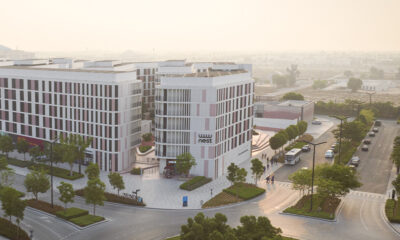Tech News
Cyber economics and the risk to critical infrastructure

By Heidi Crebo-Rediker, Senior Fellow for Geoeconomics, Council on Foreign Relations

(She is also a speaker at the Global Cybersecurity Forum Annual Meeting 2025.)
In debates on economic security, cyber economics is too often overlooked. Many still frame cyber threats as company-level problems, where firms worry about ransomware, retailers fear stolen data, and banks focus on hacked payment systems. However, the more consequential danger is collective: cyberattacks on critical infrastructure with the power to unleash cascading disruptions across entire economies. This systemic risk remains under-appreciated, even as attacks grow in scope, sophistication, and geopolitical consequence.
From corporate risk to macroeconomic shock
The greatest danger lies not in a single server, but in the complex systems that underpin modern commerce. Electricity grids, water utilities, transportation networks, ports, airports, and undersea cables carry the weight of global connectivity. While automation and software increase efficiency, they also multiply vulnerabilities.
A prolonged disruption to any one of these systems can paralyze thousands of businesses. Multiple disruptions at once could be catastrophic. The 2021 winter storm in Texas, though caused by weather rather than malware, is a sobering example. The blackout cost up to $130 billion and crippled supply chains, health services, and agriculture. Imagine a hostile actor triggering similar failures via cyberattack, deliberately timed for maximum damage. The result would not only devastate individual entities but also generate a macroeconomic shock—akin to a natural disaster colliding with a financial crisis.
The growing threat landscape
State-backed hackers and criminal groups are already probing these vulnerabilities. The Colonial Pipeline ransomware attack in 2021 exposed how fragile logistics networks can be, while the more recent Volt Typhoon campaign embedded malware inside U.S. critical infrastructure. Unlike espionage, such intrusions appear designed to disrupt the civilian economy at scale, undermining both national resilience and military readiness.
The threat is also global. Attacks on undersea cables—vital arteries of the digital economy—are no longer hypothetical. With artificial intelligence accelerating offensive capabilities, adversaries can now identify weaknesses faster and automate attacks at scale. As a result, the risk curve is steepening, placing both advanced and developing economies in danger.
The field of cyber economics
Traditional economics treats cyber risk as a minor externality to be covered by insurance. In contrast, cyber economics reframes these risks as systemic. The more integrated and digitized an economy becomes, the more vulnerable it is to disruption. Elevating cyber threats from technical concerns to macroeconomic risks sharpens the case for sustained investment in resilience.
Without realistic, economy-wide accounting of costs, both governments and markets will continue to underinvest in defense and the skilled workforce required. Initiatives such as the Global Cybersecurity Forum–World Economic Forum Center for Cyber Economics, particularly when joined by institutions like the IMF, World Bank, and OECD, represent important first steps.
Who polices, who pays?
The governance dilemma complicates the picture. In the United States, most critical infrastructure is privately owned, meaning investment decisions often follow commercial incentives rather than national resilience. Large utilities may field advanced defenses, while smaller authorities lack the means to keep pace. Even the best-prepared firms cannot realistically deter state-backed attackers without government coordination and international collaboration.
Meanwhile, state-led economies often mandate cybersecurity standards and assume direct responsibility for protecting infrastructure. Liberal democracies, however, struggle to enforce baselines or require immediate reporting. Legal restrictions and fragmented oversight create uneven defenses, leaving the broader economy exposed to “weakest link” failures. The unresolved question of who ultimately pays—federal taxpayers, private firms, or local governments—further delays progress.
The allied dimension
Because cyber threats transcend borders, national strategies alone are insufficient. Attacks on shared assets such as undersea cables, power grids, or data networks ripple across continents. Therefore, allies must elevate cyber resilience as a shared economic security priority. Intelligence sharing, collaborative monitoring, and joint investment in defensive infrastructure can help close gaps that no single nation can address on its own.
A call to action
What is needed now is a paradigm shift. Policymakers, investors, and regulators must recognize that cyber threats to critical infrastructure represent potential macroeconomic shocks, not isolated corporate challenges. The rise of cyber economics highlights that in an interconnected world, cyber defense is economic defense. Ignoring this reality risks overlooking one of the defining macroeconomic threats of our time.
Read our previous post, H-1B visa fee hike rattles tech and global markets
Tech News
Loylogic Shares 2026 Vision to Advance the Global Rewards Marketplace

Advanced AI innovation, intelligent marketplace design, and trusted global infrastructure position Loylogic for continued leadership in rewards and loyalty commerce.

As the Middle East loyalty market is projected to reach $3.27 billion in 2025, expanding 16.3% year-on-year, and digital-first, personalized, and coalition-based models reshape the industry, brands face rising expectations around relevance and engagement. Against this evolving landscape, Loylogic, a leader in global loyalty rewards management, today shared its 2026 strategic outlook, outlining how the company is evolving its global rewards marketplace to support brands navigating rapidly changing loyalty expectations.
The company enters the year with a renewed focus on continued investment in AI-powered rewards marketplace intelligence, enhanced catalogue curation, and deeper integration capabilities designed to improve reward relevance, partner value, and member experience across industries and geographies. Rather than simply expanding choice, Loylogic’s approach centres on intelligent rewards marketplace design, aligning consumer relevance, operational efficiency, and long-term value creation within a single global platform.
To support enterprise scale deployment, Loylogic continues to operate under a robust compliance and security, compliance and governance framework. The company adheres to internationally recognised standards ISO 27001, GDPR, PCI DSS, and AES-256 encryption, ensuring secure and trusted data handling across every layer of its technology while maintaining alignment with the European Accessibility Act 2025 and WCAG 2.0. All platforms remain adaptable to regional data residency and regulatory requirements.
“As loyalty programs mature, brands are looking beyond scale alone,” said Gabi Kool, CEO of Loylogic. “They want reward ecosystems that are smarter, more relevant, and commercially sound. Our focus for 2026 is about advancing how global rewards marketplaces are designed, governed, and experienced, combining intelligence, trust, and flexibility.”
Advanced AI innovation is central to Loylogic’s next phase of growth. Loylogic continues to enhance its use of advanced analytics and machine learning to support smarter reward discovery, improved marketplace performance, and deeper insights for loyalty operators, while maintaining strict standards for privacy, security, and compliance.
“Our innovation efforts are focused on making rewards marketplaces more intelligent and adaptive,” said Amit Bendre, COO of Loylogic. “This means better insight, better decision support, and better experiences, without compromising on trust, transparency, or regulatory rigor.”
Looking ahead to 2026, Loylogic plans to deepen collaboration with global partners, engage more actively with industry stakeholders, and selectively strengthen capabilities across commercial, product, and technology functions, supporting a growing pipeline of enterprise clients across financial services, travel, and consumer sectors. With a proven global infrastructure, deep marketplace expertise, and a clear strategic direction, Loylogic continues to help leading brands transform everyday engagement into meaningful, long-term loyalty.
About Loylogic
Loylogic is a leader in global rewards marketplaces for loyalty and incentives management, enabling brands to deliver scalable, flexible engagement experiences through a modern commerce platform. Its global catalog and redemption marketplace support meaningful engagement across B2C, B2E, and B2B programs worldwide. With deep expertise in sourcing, fulfilment, and patented points-plus-cash innovation, Loylogic has enabled over 200 billion points and miles transactions, delivered more than $1 billion in commerce, and shipped experiences spanning 100+ categories across 190 countries to more than 10 million loyalty members worldwide.
Tech News
Webook.com Strengthens UAE Footprint, Bringing World-Class Entertainment Experiences

Webook.com, one of the fastest-growing platforms for booking lifestyle and entertainment experiences in the Middle East, is deepening its footprint in the United Arab Emirates following strong traction across the country.
Founded with a vision to transform how people discover and book experiences, webook.com continues to elevate convenience through a unified platform that brings together entertainment, dining, and leisure in a seamless digital journey.
Within the UAE, webook.com has rapidly expanded its user base while curating a lineup of world-class experiences. From comedy nights with Bassem Youssef to electrifying Teddy Swims concerts and the magic of Disney on Ice, webook.com continues to bring some of the region’s most unforgettable events to audiences across the UAE. Beyond these major hosted events, users can also book global entertainment experiences, including MDLBEAST, Riyadh Season, AFCON and other leading events happening across MENA.
Commenting on the expansion, Nadeem Bakhsh, CEO of webook.com, said: “Webook.com was built to curate the experiences that matter most, from front-row access to world-class entertainment to discovering hidden local gems. Expanding our footprint to the UAE allows us to bring a carefully selected lineup of events and experiences to the region. Our goal is to continue providing variety, quality, and seamless access to unforgettable moments.”
As the platform widens its presence across the UAE, it continues to strengthen partnerships with top entertainment brands, cultural institutions, and iconic venues, enabling users to access an unmatched selection of events and experiences.
Webook.com’s technology has proven itself across multiple markets, handling millions of transactions during major events, tournaments, and high-demand ticket releases. With real-time queueing, robust infrastructure, and flexible integration, webook.com delivers landmark events with unmatched reliability and scale.
With momentum accelerating in the UAE, webook.com aims to transform how people discover, plan, and enjoy experiences, turning every booking into the start of a memorable story. Beyond expanding its presence, webook.com is shaping a movement centered on connection, culture, and the joy of shared moments.
Tech News
AI INNOVATION IN HEARING CARE MUST ACCELERATE AS 2.5 BILLION COULD FACE HEARING LOSS BY 2050

With nearly 2.5 billion people projected to have some degree of hearing loss by 2050 as per World Health Organization, Starkey MEA is calling for faster adoption of AI-enabled hearing innovation that delivers practical, measurable improvement for patients in real-world environments.
AI is reshaping what hearing aids are expected to do. The category is moving beyond basic amplification toward systems that can interpret complex soundscapes, prioritise speech, and personalise output moment by moment—especially in noise, multi-speaker settings, and fast-changing environments. Starkey says this shift demands on-device intelligence that is fast, power-efficient, and clinically meaningful, rather than “AI” that lives mainly in marketing language.
“Talking about AI is easy. Delivering AI that makes hearing clearer when life is noisy, and that does it reliably all day, is the real standard,” said Giscard Bechara, Regional Director, Middle East & Africa, Starkey MEA. “With the scale of hearing loss projected globally, innovation can’t crawl. In MEA, our focus is to bring on-device intelligence that adapts in real time to the person and the environment—because that is what patients actually feel. We will also be introducing a new AI-driven hearing solution in the region soon, and we look forward to sharing what this next step means for hearing professionals and the communities they serve across the Middle East and Africa.”
As part of a wider drive to promote hearing health awareness across the Middle East, Starkey MEA has highlighted how AI-led hearing technology can be engineered to mirror the way the brain processes sound. In regional communications around its latest platform direction, Starkey has stated that its AI-based processing can make up to 80 million personalised adjustments per hour, with the intent of helping wearers stay comfortable and connected across different listening situations.
Starkey’s progress in AI processing has been built over multiple technology generations. In earlier platform disclosures, the company described its Neuro Processor architecture as delivering six times more transistors, ten times more memory, and up to four times faster processing than the prior generation—advances designed to support higher-speed analysis and optimisation without compromising everyday usability.
Starkey had introduced Edge AI featuring the G2 Neuro Processor, which the company describes as incorporating a Neural Processing Unit (NPU) with deep neural network (DNN) processing capabilities, and as being engineered for strong performance while maintaining “industry-leading battery life.” Starkey also claims the G2 includes the “industry’s only NPU fully integrated into the chip.”
In parallel, Starkey continues to frame hearing technology as a platform that can support aspects of health and safety, alongside hearing performance. The company has announced hearing aids with built-in balance assessment and has linked this to fall-risk screening frameworks, including referencing the CDC’s STEADI initiative, as well as ongoing work validating balance assessment approaches with external research partners.
Starkey MEA continues to work with hearing care professionals across the region to support patient awareness, strengthen hearing health conversations, and accelerate access to next-generation AI-enabled hearing solutions as they become available in-market.
-

 Tech News1 year ago
Tech News1 year agoDenodo Bolsters Executive Team by Hiring Christophe Culine as its Chief Revenue Officer
-

 VAR8 months ago
VAR8 months agoMicrosoft Launches New Surface Copilot+ PCs for Business
-

 Tech Interviews2 years ago
Tech Interviews2 years agoNavigating the Cybersecurity Landscape in Hybrid Work Environments
-

 Tech News5 months ago
Tech News5 months agoNothing Launches flagship Nothing Phone (3) and Headphone (1) in theme with the Iconic Museum of the Future in Dubai
-

 Tech News2 years ago
Tech News2 years agoBrighton College Abu Dhabi and Brighton College Al Ain Donate 954 IT Devices in Support of ‘Donate Your Own Device’ Campaign
-

 VAR1 year ago
VAR1 year agoSamsung Galaxy Z Fold6 vs Google Pixel 9 Pro Fold: Clash Of The Folding Phenoms
-

 Editorial1 year ago
Editorial1 year agoCelebrating UAE National Day: A Legacy of Leadership and Technological Innovation
-

 Cover Story10 months ago
Cover Story10 months agoUnifonic Leading the Future of AI-Driven Customer Engagement

























